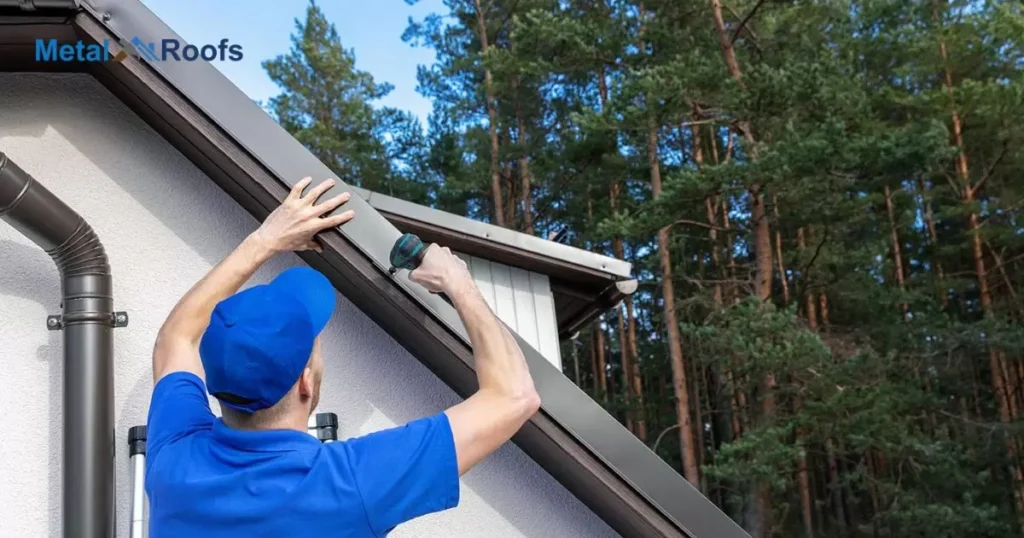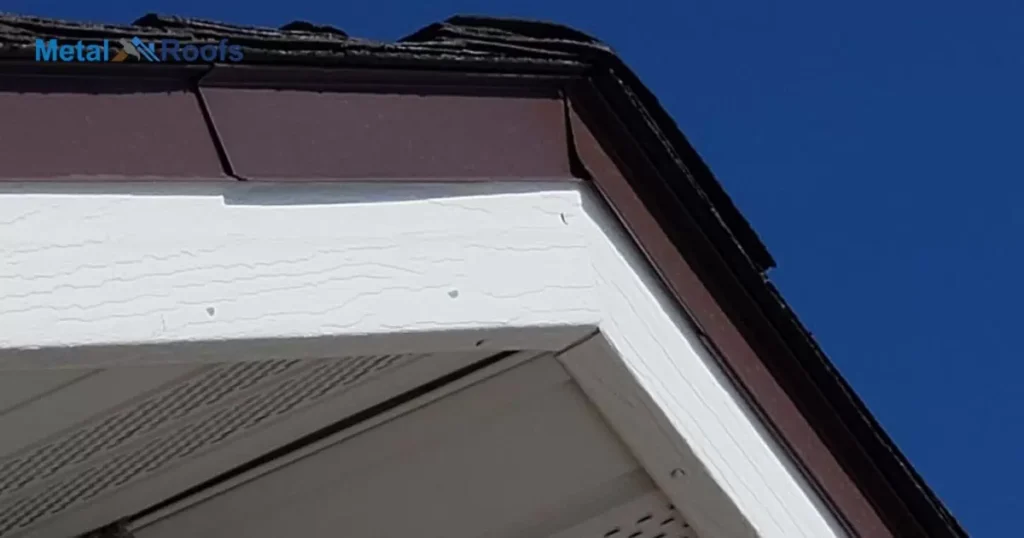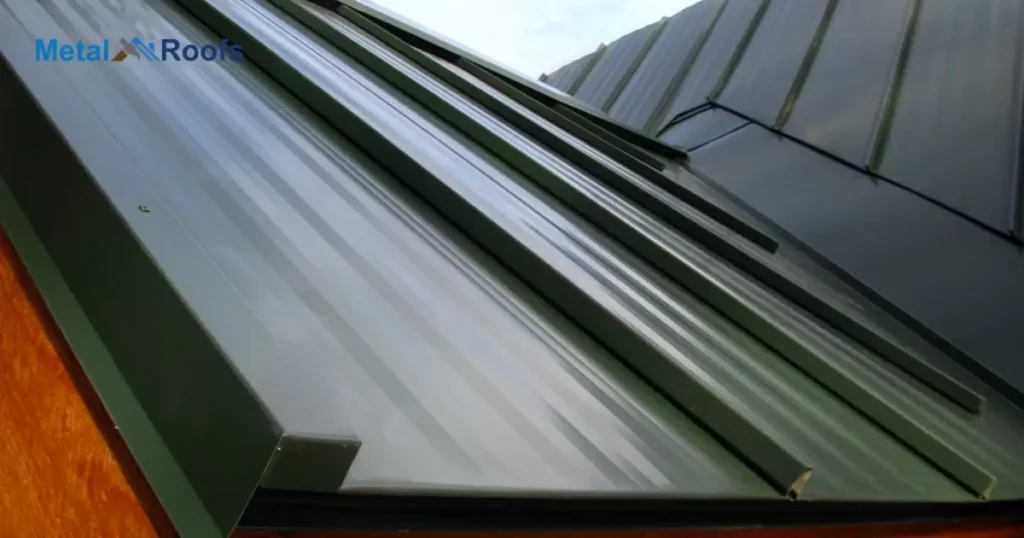A drip edge is a piece of metal installed along roof edges that overhangs past fascia boards; it diverts water away from wood and siding, allowing it to drip clear of walls and foundations, preventing rot and decay while protecting structural integrity.
Metal roofs shed water well, but unmanaged runoff can cause damage. Do I need a drip edge for a metal roof? Yes, this roof edge flashing directs rain and snow melt off the roof’s edge, preventing rot, leaks, cracks, and mold while protecting your home’s structure over time.
A drip edge controls water flow off a metal roof. This roof edge flashing channels runoff into gutters. Properly managing precipitation protects fascia, rafters, framing and sheathing from water damage. A quality drip edge is essential for any metal roof installation.
Key Takeaways
- Drip edges are crucial for metal roofs, directing water away to prevent damage.
- Without a drip edge, water can seep into the structure, leading to rot and mold.
- Proper installation of drip edges enhances the sustainability of metal roofing.
- They provide structural support, protect fascia, and maintain the roof’s aesthetic appeal.
- Plywood under the metal roof offers stability and a smooth surface for installation.
Does a Metal Roof Need a Drip Edge?

Yes, a metal roof needs a drip edge. It’s like a protective shield for the edges of the roof. Without it, water can sneak underneath, causing damage. A drip edge guides water away from the fascia, preventing issues like rot and mold. Plus, it adds a neat finish to your roof’s look. Overall, a drip edge is a smart addition to any metal roof, keeping it safe and sound for the long haul.
Why Is a Drip Edge Recommended?
It prevents water damage, like rot and mold, by keeping moisture out. It adds a polished look to the roof’s edge, enhancing its overall appearance. Overall, a drip edge is a valuable addition to ensure the longevity and functionality of a metal roof.
Benefits of a Drip Edge on Metal Roofs
Water Protection: Channels water away, preventing leaks and damage.
Prevents Rot: Guards against decay by keeping edges dry.
Ice Dam Prevention: Stops ice buildup, reducing winter damage.
Aesthetic Finish: Provides a clean edge for a polished look.
Longer Lifespan: Protects roof, minimizing need for repairs.
Water Redirection
Water redirection is crucial for a metal roof’s health. A drip edge ensures water flows away from vulnerable spots, such as Valleys Metal Roofing. It prevents damage, like rot and mold, keeping your roof sturdy. So, yes, a drip edge is vital for effective water redirection on a metal roof.
Seal the Opening to Your Attic
When sealing the opening to your attic, ensure it’s airtight. Use weather stripping or foam insulation to keep out drafts. This helps maintain energy efficiency and prevents moisture buildup. A properly sealed attic complements the protection provided by a drip edge on your metal roof.
Protect the Exterior Value of Your Home
To protect the exterior value of your home, a drip edge is essential. It shields the edges of your metal roof, preventing water damage. With a drip edge, you ensure your home stays in top shape, maintaining its value over time.
A Clean, Neat Appearance
A drip edge isn’t just about function; it adds to the roof’s appearance too. It gives a clean, neat edge that enhances the overall look. Without it, the roof might seem unfinished or messy. So, for both function and aesthetics, a drip edge is a wise choice for a metal roof.
Metal Roof Edge Trim
Metal roof edge trim is essential for proper water management. It directs water away from the roof edges, preventing damage. This trim protects the fascia, reducing the risk of rot.
It enhances the roof’s appearance, giving it a clean finish. Installing metal roof edge trim ensures long-term durability and performance, making it a crucial element in roofing systems.
Bull Nose Drip Edge

The bullnose drip edge is crucial for a metal roof. It provides an elegant finish while directing water away. This prevents damage to the fascia and underlying structure. Without it, water could seep and cause rot.
With a bullnose drip edge, water flows smoothly off the roof. It safeguards against potential leaks and prolongs the roof’s lifespan. This simple addition ensures both functionality and aesthetic appeal, making it a wise choice for any metal roofing project.
Specific Drip Edge Designs For Metal Roofing
Drip edges for metal roofing come in various designs to suit different needs. They’re crucial for managing water flow and preventing damage. Common designs include L-shaped, T-shaped, and hemmed edges.
L-shaped drip edges are simple and effective, providing a protective lip along the roof’s edge. T-shaped edges offer additional coverage, directing water away from both the roof and the fascia. Hemmed edges have folded edges for added strength and durability. Each design serves a specific purpose in safeguarding your metal roof against water damage.
Metal Roofing Differ From Other Roofing Materials
| Aspect | Metal Roofing | Other Roofing |
| Lifespan | Up to 50+ years, minimal maintenance | Shorter, more maintenance |
| Durability | Resistant to weather, hail, snow | Less resilient |
| Maintenance | Minimal upkeep | Often requires more repairs |
| Weight | Lightweight | Heavier, may need extra support |
| Aesthetics | Sleek, modern | Varied appearance |
| Sustainability | Sustainable due to longevity | Varies by material |
Metal roofing stands out from other roofing materials due to its durability. Unlike traditional shingles, metal roofs can last up to 50 years or more, requiring minimal maintenance. This longevity makes them a cost-effective choice in the long run.
Metal roofs are highly resistant to various weather elements such as rain, snow, and hail. This resilience reduces the risk of leaks and water damage, offering better protection for the underlying structure of the building. Metal roofing is lightweight, making it easier to install and putting less strain on the overall structure of the house.
Drip Edge And Metal Roofing Aesthetics
A drip edge is crucial for metal roofs. It adds a sleek finish to the roof edges. This small detail enhances the overall aesthetic appeal. Without a drip edge, the roof might look unfinished.
The drip edge helps in water management. It prevents water from pooling at the edges. Overall, a drip edge is essential for both functionality and aesthetics when it comes to metal roofing.
Drip Edge And Metal Roofing Sustainability

Drip edges are vital for metal roofs. They manage water, preventing damage to the roof and structure. Without them, water could seep in, causing rot and mold. Plus, drip edges protect the roof’s edges and enhance its appearance. They’re crucial for long-term sustainability.
Metal roofing is sustainable, but it needs proper installation. Drip edges play a key role here. They ensure water is directed away, preventing potential issues. So, when considering a metal roof, don’t forget the importance of drip edges for sustainability.
Frequently Asked Questions
What do you put on the sides of a metal roof?
You put drip edges on the sides of a metal roof. They manage water flow and protect the edges from damage.
How important is a drip edge on a roof?
A drip edge is crucial for directing water away from the roof edges, preventing damage and enhancing longevity. It’s a vital component of roof protection.
Do you need plywood under a metal roof?
Yes, plywood provides structural support and a smooth surface for metal roof installation.
Conclusion
A drip edge is crucial when installing a metal roof. This angled flashing directs water away from vulnerable infrastructure. Proper water diversion prevents decay and leaks. Though simple, a drip edge profoundly impacts function and lifespan. Invest in quality edges for optimal performance.
Don’t chance runoff issues – add a drip edge. Prefabricated galvanized steel provides durability and longevity. Have a roofer integrate the edge during roofing for best results. Take this simple measure to protect fascia, rafters and sheathing from moisture. Your metal roof will function and look great for years.











